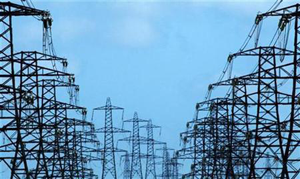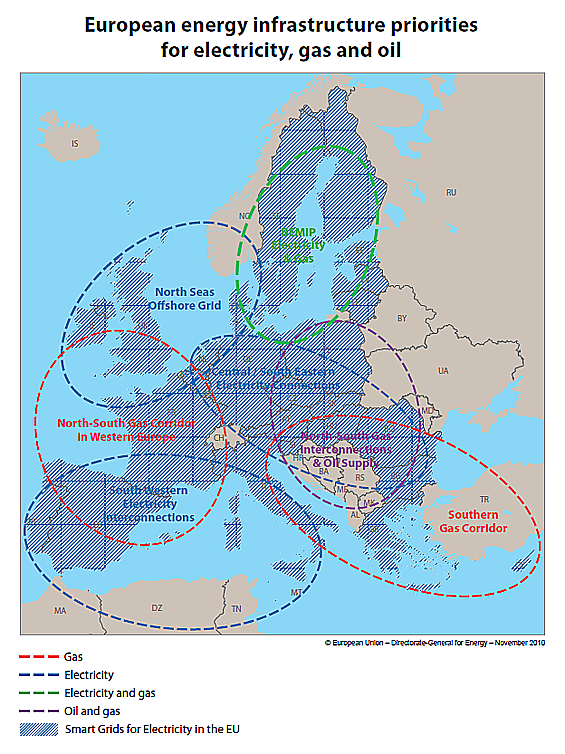New Approach towards "the life blood of our society" - EU Energy Infrastructure
on
New Approach towards “the life blood of our society” - EU Energy Infrastructure
The importance of energy infrastructure for the integration of European energy markets is unquestionable. The European Union and its member states have already recognized many times the significance of the development of trans-European networks, contributing to the achievement of the EU´s ambitious energy and climate goals (20/20/20 targets, decarbonisation, competitiveness, sustainability, security of supply, and elimination of energy isolated islands). [note 1]
 |
| Power lines and pylons (c) Luke MacGregor / Planetark.org |
Obstacles
The EU energy infrastructure remit was initially set by the trans-European Networks for Energy framework (TEN-E), and considerably enhanced by the European Energy Program for Recovery (EEPR). While the budget of TEN-E for 2007-2013 represented “only” €155 million, the EEPR for 2009-2010 earmarked for energy projects an interesting package of €3.98 billion. However, in comparison with the Commission’s estimate of €1 trillion [note 2] needed to invest in Europe’s energy system by 2020, this amount seems like a drop in the ocean. Therefore a significant financial gap regarding European energy infrastructure still exists. In this regard, the EU believes that its intervention would stimulate commercial funding involvement, driving targeted energy priorities forward. Additionally to
a) the leverage of private investments, other issues requiring an adequate European strategy have been identified, inter alia:
b) Too broad priorities and too many “strategic” projects;
c) Uncertain and slow authorisation procedures; and
d) Missing effective cross border cooperation and allocation of costs.
To remove these obstacles, the Commission proposed a Regulation on guidelines for trans-European energy infrastructure on 17 October 2011,
| Therefore a significant financial gap regarding European energy infrastructure still exists |
Projects of Common Interest - PCI
Only projects helping the implementation of at least one of the 12 strategic trans-European infrastructure corridors and areas relating to electricity/gas transmission and storage, LNG/CNG facilities, oil/CO2 networks, and smart grid technologies and covering different geographical regions of the EU could be labelled as PCI. Preferential status will only be received by projects on the Union list created every two years (for the first time by 30 September 2013). The logical question is how to get onto this exceptional list?
 |
| Source: http://ec.europa.eu/energy/infrastructure/strategy/doc/2010_11_17_infrastructure_map.pdf |
The whole process commences with the submission of an application by a project promoter to the Regional Group attached to a particular strategic corridor or area. These Regional Groups, composed of the representatives of the Commission, Member States, TSOs, national regulatory authorities, ACER, ENTSO-E/G, and other stakeholders if applicable, will evaluate and rank the proposed projects. At the end, their draft regional lists will be filed to the ACER at least six months before the Union list adoption date. ACER will have three months to provide its opinions, and the Regional Groups, where decision-making rights are assigned only to the Commission and Member States, will subsequently finalize their regional lists within one month. Within an additional two months the Commission will be obliged to create the final Union list of PCI with a manageable number of projects, i.e. it could narrow down the regional lists, if necessary.
Clearly, various stages of the PCI selection would create scope for lobbying and manipulation from interested parties. Against these circumstances, it might be difficult to protect wider EU goals over national or individual interests. One of the solutions could be transparency - not only the final list and selection criteria, but also a detailed evaluation of particular projects should be published. But there is also the matter of very commercially sensitive information…
Another concern relates to the feasibility of the first Union list timetable (scheduled as following):
| Deadlines | Adoptions of |
| 31-Mar-2013 | draft regional lists |
| 30-Jun-2013 | ACER´s opinions |
| 31-Jul-2013 | final regional lists |
| 30-Sep-2013 | final Union list |
Although the Regional Groups already exist and work, they are unable to follow the adopted timetable of the Regulation that is expected to come into force only someday in April 2013. Who is lagging behind?
Smoother administrative procedures and motivating regulation
One of the most important steps forward seems to be the approach intended to streamline the permit granting processes, which are usually quite long and complex (mainly due to the engagement of many administrative bodies) irrespective of the Member State. To address this hurdle, the Regulation has laid down various measures.
First of all,
| The logical question is how to get on this exceptional list? |
Secondly, the matter of public participation is dealt with. It is not a secret that many citizens support renewable energy (sources), such as wind farms, until the moment they are to be constructed in their vicinity. Admittedly, social acceptance/resistance becomes increasingly important especially in the European environment. As a result, the Regulation sets rules regarding public consultations, transparency, the website of PCI, etc. enabling all stakeholders to be properly informed and listened to, if interested.
Last but not least is the limitation of the duration of the authorisation procedure to 3.5 years (with a maximum potential prolongation of nine months). Certainly this effort will be highly appreciated due to the fact that some investors experience unbearable delays regarding administration [note 3]. However, for the effectiveness of this measure, a possible infringement procedure will be crucial in order to promote adherence to the approved time limits. In the end, unsubstantiated prolongations might lead to steps for remedies from the concerned project promoters.
The Regulation also tackles the sensitive issue of cross-border investment costs allocation. Admittedly, the energy infrastructure project in one Member State can have a positive impact on another Member State, e.g. the extension of grid capacity increasing cross-border electricity transfer, gas reverse flow strengthening the security of supply of neighbour(s), or LNG terminal supplying more countries. Nevertheless, sometimes a national view doesn’t take into account the broader European or regional benefits, and Regulators might have a tendency to reduce “national” tariffs as low as possible, thus “protecting” their citizens. Therefore, the endorsed approach states that efficiently incurred construction costs should be reflected in the tariffs for network access in line with the “user pays” principle. If the concerned Regulators cannot achieve an agreement, ACER will step in and make a decision. Most likely a small problem might arise with regard to requests for the cross-border allocation of costs connected to the first Union list of PCI, which has to be submitted by 31 October 2013; who knows whether this list will exist by that time.
EU´s financial assistance
There may be great procedures, thorough analyses, and cooperating Regulators, but if we do not have enough money our ambitions cannot be met. Obviously, limited public funds are unable to cover the enormous expenditures linked to energy infrastructure plans, and market forces cannot solve all problems.
| Therefore we need to involve private investors |
The multi-annual financial framework 2014-2020 will most likely reserve a financial package for energy infrastructure under the Connecting Europe Facility. In this respect, the Commission initially proposed to set aside funding of €9.1 billion. However, after the November 2012 deadlock on MFF, President Van Rompuy suggested a compromise of €7 .1 billion, and the February European Council shrunk this amount to €5.1 billion. Although the European Parliament rejected the suggested MFF, it didn’t contest the ceiling. Consequently, we could expect a sum of €0.73 billion per year to be earmarked for energy infrastructure by 2020. Is it a small or large amount of money? It depends - in comparison with EEPR it is much smaller, but compared to the TEN-E much larger…
Conclusion
The intention to move forward infrastructure projects with positive impacts shared between member states to the EU level is definitely promising. In this respect, the Regulation might play a crucial role in the achievement of the EU´s goal to finalise the internal energy market. The rules to identify strategic projects, to simplify and shorten permitting procedures, to allocate cross-border costs, and to provide financial aid have the potential to attract investors. This is the theory, and only practical application will check their efficiency. Although the start of the new approach is not ideal due to the unrealistic timeline of the 1st Union list, it is not a tragedy. Crucial will be the ability to resist the attempts of particular stakeholders to influence the EU´s funding allocation. Are we (European off-takers) rich enough to bear stranded costs (e.g. through the support of pipe-to-pipe competition)? In this respect, the selection of winning "veins" should be as transparent as possible. Funds are limited, and they should be used effectively. Hopefully the EU and member states will be able to find a reasonable approach in order to improve the security of supply, to finalise the internal market, and to minimise unused capacities.
Notes
1) e.g.: Energy infrastructure priorities for 2020 and beyond - A Blueprint for an integrated European energy network
2) Energy 2020 - A strategy for competitive, sustainable and secure energy
3) See Ten-Year Network Development Plan 2012


Discussion (0 comments)